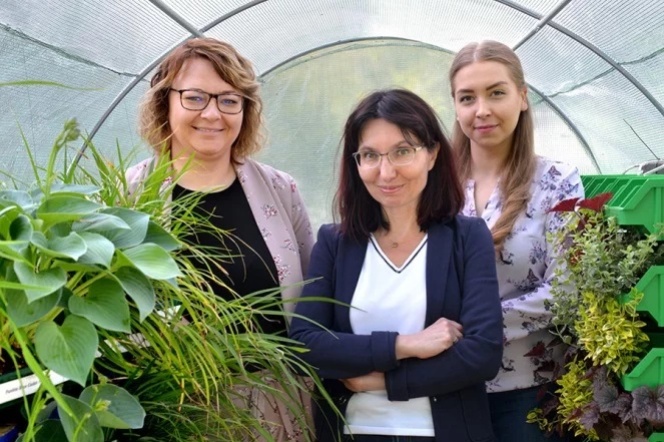Date added: 2022-07-07
Hydroponics and a closed-loop water system – lettuce on a wall

Hydroponics is a method of growing plants without soil, using nutrient containing mineral salt solutions. Hydroponic crops can be grown not only on an industrial scale, but also in home gardens, increasing self-sufficiency of cities when it comes to food production. However, relatively large water consumption and cleaning the used nutrient are disadvantages of this solution. The objective of the research conducted by researchers form the Faculty of Civil and Environmental Engineering is to close water circulation in hydroponic lettuce cultivation by cleaning the leachate in the green wall system.
Urban farming is becoming more and more popular among city residents who want to be in contact with nature and have gardens where they can grow vegetables or fruit for their own use. However, not everyone can afford a traditional home garden, and allotment gardens, once so popular, are often liquidated and designated for development. However, the growing density of buildings does not have to mean resignation from urban crops - vertical systems, characterized by a small space requirement, may be the answer to these problems. Vertical gardens, located on the walls of houses, companies and institutions, or crops located on the roofs of buildings are the so-called "urban farming" - more often observable also in Polish agglomerations.
Prof. Ewa Wojciechowska and Karolina Matej-Łukowicz, PhD Eng from the Department of Sanitary Engineering at the Faculty of Civil and Environmental Engineering and student Joanna Stycharz, conduct research on connection of two vertical systems. The first is used for hydroponic lettuce growing, while the second is the so-called green wall intended for flushing the leachate.
Crops independent of atmospheric conditions
Hydroponics not only eliminates the need to plant in the ground, but also the demand for access to natural light. This type of cultivation can be done in closed rooms, using special lamps with appropriate light intensity instead of sunlight for photosynthesis, required in the plant growth process. This also eliminates the problem of unfavorable weather conditions - cultivation can be all year round. Plants are also not susceptible to soil-borne diseases, which reduces the use of plant chemicals.
– Hydroponics is also a response to long food supply chains and the rising prices of fresh food in cities. By cultivating plants for private use, we shorten the path between the place of production and our table. Soilless crops are a response to the challenges associated with the need to feed a dynamically growing population. - emphasizes Prof. Ewa Wojciechowska, the project manager.
As part of the currently conducted project Radium Learning Through Research Programs, a system for hydroponic lettuce cultivation was constructed. Lettuce seedlings mature in greenhouses, then they are transplanted into special baskets, printed on a 3D printer and placed in tubes filled with nutrient solution, with holes cut for pots. Thanks to this structure, the crops can be placed in the selected room both horizontally and vertically, depending on the needs and the availability of space.
– It's a cheap solution. Except for the baskets, which purchase was difficult, and we were helped by a student of the Faculty of Telecommunications and Informatics who designed and printed an appropriate size and shape openwork containers on a 3D printer for the seedlings, we used sewage pipes that we received from Pipelife. Additionally, we needed a suitable lamp - lettuce requires light at a temperature of 6500 K and our hydroponic cultivation had the right conditions. - explains Karolina Matej-Łukowicz, PhD Eng.
In the project, researchers from the Faculty of Civil and Environmental Engineering focus primarily on verifying the possibility of treating wastewater from hydroponic lettuce cultivation using a green wall and closing the water circulation in this culture.
Response to concreteosis and lack of space
Green walls are an increasingly popular trend in urban agglomerations. They are a response to the "concreteosis" that harasses the cities, however their function is not limited only to the aesthetic aspect. They have a positive effect on the microclimate, reducing the "urban heat island" effect. They can also successfully purify water - most often they are used to purify rainwater or the so-called graywater, enabling its reuse. A novel idea in the Radium project is to use a green wall to purify the leachate from hydroponic cultivation.
– We want to investigate whether the used water, which further forms the nutrient solution, can be used one more time, or even several times, emphasizes Karolina Matej-Łukowicz. - Closed circulation allows for a significant reduction in the amount of water used for hydroponic cultivation, which is extremely important due to climate change, the result of which is, among others, problem with water availability. However, in order to close such a cycle, we have to purify the water. And here comes the help of a green wall made of several floors of plants that will filter our water, purify it and allow its another use for the cultivation of lettuce.
Researchers use various plants to create green walls, including: euonymus or heuchera, and test their filtering abilities.
– Our goal is to create the right nutrient medium so that the lettuce grows in the best possible conditions, and the right green wall to clean the used nutrient medium and introduce closed circulation - summarizes Joanna Stycharz, student of environmental engineering.

